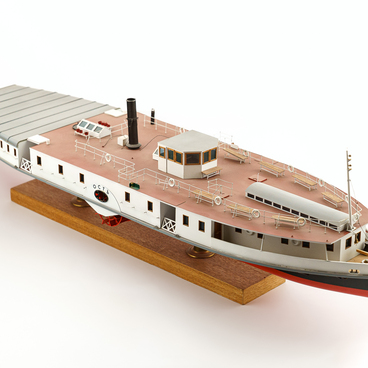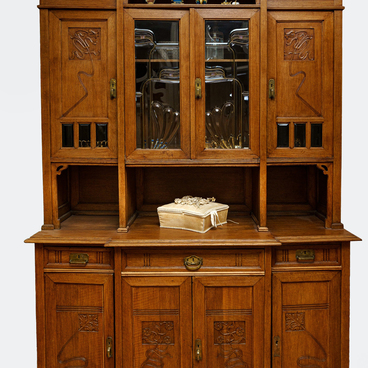The museum’s exhibition presents a reconstruction model of the city of Yaroslavl in the 13th century. It is based on a table top in the shape of an irregular polygon. The table top is flat, coated in brown color, its sides and bottom are painted in white color; it has wooden supports. The plaster base of the model depicting the terrain is fixed on the table top. Small pieces representing city buildings are attached to the base from above: churches, houses, city walls, fences, bridges, and also vegetation — trees are made of fragments of dried plants. The base is painted in shades of natural colors in some places. The buildings are mostly brown.
In the 11th–12th centuries, Yaroslavl remained a small guard post on the outskirts of the Rostov-Suzdal principality, the Volga outpost of its “elder brother” — Rostov the Great. It was also an advantageous position to watch the approaching caravans of trade ships or enemy boats. From the field side, the fortress was protected by the deep Medveditsky ravine. At the turn of the 13th century, as the Volga trade route was getting busy, Yaroslavl began to develop due to its favorable geographical position. The peak of its prosperity in the pre-Mongolian period happened during the reign of Rostov Prince Konstantin Vsevolodovich (1207–1218) and his son Vsevolod (1218–1238).
In 1218, Prince Konstantin divided his possessions
between his two sons: “he sent his elder son Vasilok to rule Rostov, and
Vsevolod to rule Yaroslavl.” Thus, in the period of strengthening feudal
fragmentation Yaroslavl became the capital city of the new principality. The
rise of the city led to the start of large construction works, affecting first
of all the territory of the princely residence on Strelka. Its appearance can
be reconstructed only on the basis of relatively late chronicle sources and
data of archeological excavations. The fortress was wooden. Around a small,
log-paved square, the houses of the prince’s retinue and numerous servants were
crowded together. Above them, there was a two-storied wooden princely palace
with spacious entrance halls. In 1215, Prince Konstantin “laid a stone church
in Yaroslavl in his courtyard in the name of the Holy Dormition of the Mother
of God.”This first stone building of the city, which stood in the center of the
Kremlin ensemble on Strelka, has not survived.





